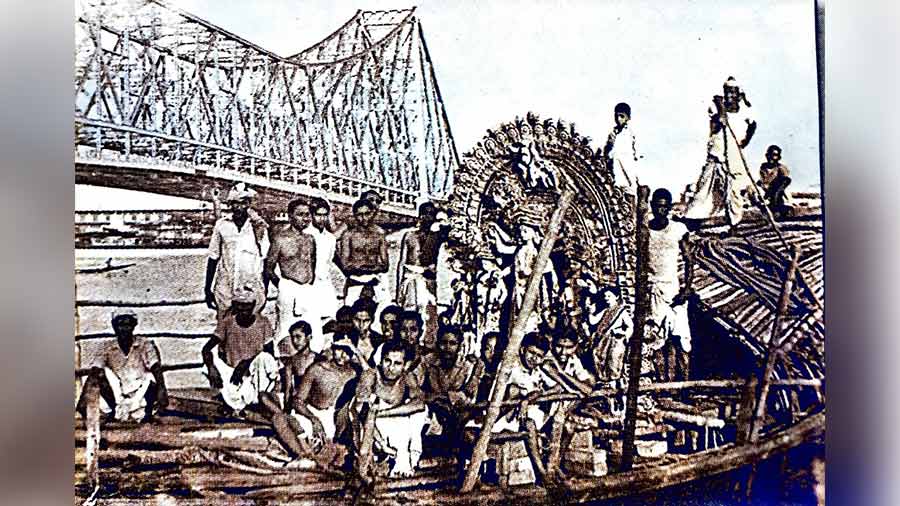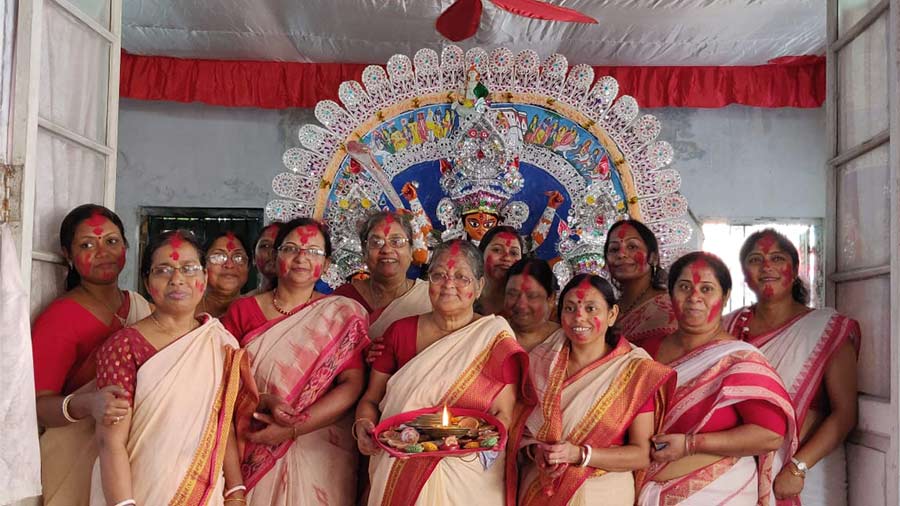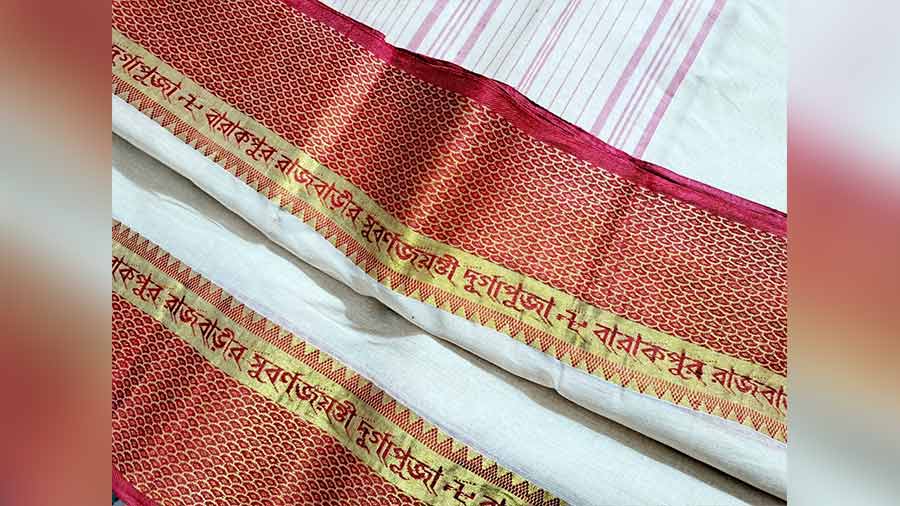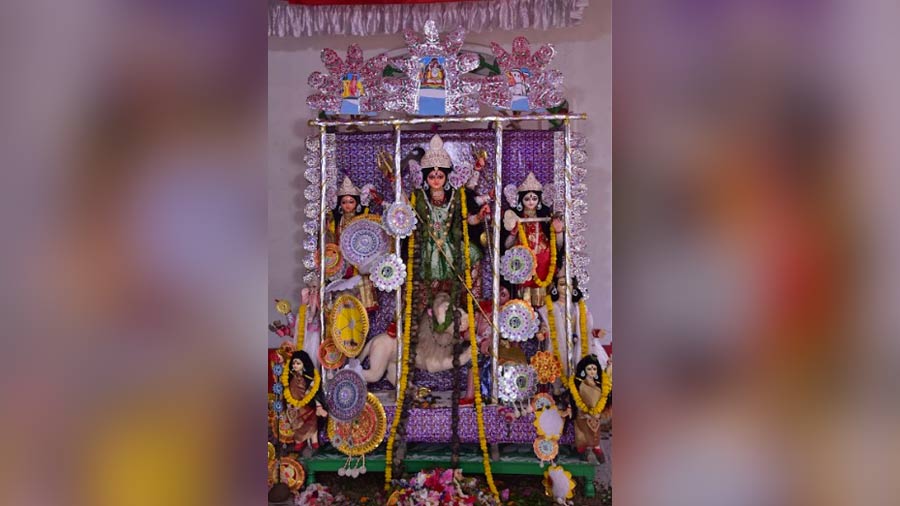Bonedi barir Durga Pujas have a charm of their own. One such puja is organised by the Dasgupta family of Kalia Niwas or Kaviraj bari in Barrackpore.
The rich history of the family puja started in Senhati of Jessore, a village on the banks of river Bhairav, now in Bangladesh.
Narahari Das aka Kabindra Biswas, born in 1510, was a noted scholar of the Tantrik cult and was also a member of the royal court of Kamrup. In the early 16th century, when the Bhakti movement started, Hindus in Bengal witnessed a religious resurgence after a prolonged suppression by the Islamic rulers. The wave continued for the next 200 years or so, and by that time, Narahari’s great grandson Madhusudan Dasgupta had already moved to a village named Kalia. There, he started the family Durgotsav, most probably in 1622. If the year turns out to be factually correct, then the puja which has now shifted to Baracpore in 1956, after the family was uprooted from Jessore within two years of the Partition of India, is now 400 years old.

An old photo of an immersion, taken in 1954, from Dasguptas’ family album
Puja follows Shakta rituals
The family puja of Dasguptas follows pure Shakta rituals, where Devi is worshipped as a mother and an embodiment of collective power of all celestial forces. She is worshipped according to Kalika Purana, from which Naraharidas compiled various rituals of this puja. Narahari’s compilation was copied many times and first printed in 1885 and then in 1965. The present puja follows the last version.
Here, Durga is offered non-vegetarian food along with liquor, as it is described in many sacred texts that at the time of killing Mahisashura, Devi Durga intoxicated herself by drinking liquor to gain extra energy.
‘Glad animal sacrifice has stopped’
Also, animal sacrifice was a part of the puja till 1996, which has now stopped. “Because of our forefathers’ tantric background, offering blood to Goddess Durga was an intrinsic part of the puja. There used to be animal sacrifices even on Pratipada and other days of puja. I am glad, now these gory affairs have stopped,” said 62-year-old Subrata Dasgupta, who is an active member of the puja.
Though the family does not allow widows to participate in the baran ceremony, it includes the names of all female members during the sankalpa, along with names of male members. This is an exceptional facet of this puja.
The idol is made in typical ekchala style and the skin color of Durga is tapta kanchan, a blend of orange and yellow. The lion is surprisingly a replica of an African lion that looks a bit misfit in such a traditional puja.The idol is decorated with gold ornaments, some of which are vintage and being in use for many years now. Devi is offered a spectacular arati with the beatings of traditional dhaak every evening.
A gala reunion for Dasgupta family
The puja is now organised by Madhusudan Dagupta’s descendants. Going by the records, some members of the other branches of the family also participate in this puja. Over the years, the family branched into nearly 26 small families, who are spread across the globe. Before the family moved to India from East Pakistan in 1956, Nishinath Dasgupta and Jitendranath Dasgupt’s families were connected to this puja. The puja is completely financed by family members and done under the watchful supervision of Anup Dasgupta, the senior most member of the family.
The puja days see a gala reunion. Nearly 80 people gather from Saptami onwards and the house keeps buzzing with activities.
Durga baran only by married women
On Dashami, the idol is taken for immersion after a classical baran conducted by the married women of the family followed by a group photo session. Soon after, all the family members gather at the Durga dalan for pronam, kolakuli and mishtimukh.

The women of the Dasgupta family gather for a group photo session after the baran Sohini Dasgupta
To commemorate 50 years of their puja in Barrackpore, the Dasguptas printed and circulated an informative book in 2005 that covered a short family history and the rich heritage of Durgotsav, which dates back to 1622. To make the event even more memorable, every daughter and daughters-in-law were presented a unique memento, a Tangail handloom sari with ‘Barrackpore Rajbari Subarnojayanti Durga Puja’ woven on the border. It was presented by the eldest living lady of the family, Niharkana Dasgupta. The women still try to wear it on every Durga Puja when they meet at Kalia Niwas in Barrackpore.

Tangail handloom sari with ‘Barrackpore Rajbari Subarnojayanti Durga Puja’ woven on the border that every woman in the family wears Somen Sengupta
Subrata is extremely optimistic that the legacy of this 400-year-old puja will be carried forward by the younger members of the family. “Even a few years back, we elders thought that the zing of this puja will vanish eventually. But seeing the involvement of the younger generation, now we know we were wrong. Our family puja that started in Kalia, will see many more decades of celebrations,” Subrata signs off on a hopeful note.


